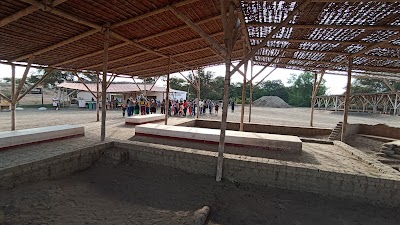Huaca Rajada - Sipán (Huaca Rajada - Sipán)
Overview
Sipán, also known as **Huaca Rajada**, is a remarkable archaeological site nestled in the **Lambayeque region of Peru**. This site gained international fame with the discovery of the **tomb of the Lord of Sipán**, one of the most significant archaeological finds in the Americas, unveiling a wealth of cultural and historical treasures from the ancient Moche civilization.
The intriguing story of Sipán's discovery began in **1987** when Peruvian archaeologist **Walter Alva** learned that local looters had stumbled upon an ancient tomb. Recognizing the potential importance of this find, he swiftly assembled a dedicated team to investigate further, leading to the unearthing of an extraordinary burial site that had remained untouched for centuries.
Within this tomb, archaeologists uncovered the remains of the **Lord of Sipán**, a ruler from the Moche civilization who lived around **1,700 years ago**. His grave was adorned with a stunning array of **gold, silver, and copper ornaments**, showcasing the wealth and status of this ancient leader. This discovery was groundbreaking, as it marked one of the first intact royal tombs found in the Americas, containing elaborate jewelry, weapons, and ceremonial artifacts that reflected the high status of the individual buried within.
The tomb was not a solitary resting place; alongside the Lord of Sipán, archaeologists discovered several other remains, believed to be individuals sacrificed to accompany their ruler into the afterlife. Among these were two young women, a child, three male warriors, a dog, and a llama. This finding highlights the complex and ritualistic burial practices of the Moche, offering profound insights into their beliefs about life, death, and the afterlife.
The site of **Huaca Rajada** is characterized by two large adobe pyramids and a series of platforms, constructed by the Moche civilization, which thrived from **100 to 700 AD**. These impressive structures were made from thousands of meticulously crafted adobe bricks and served as ceremonial and religious centers where rulers were both worshipped and interred.
Excavations at Huaca Rajada have continued to yield fascinating discoveries, enhancing our understanding of the Moche civilization's sophisticated artistry, engineering, and social structures. Numerous additional tombs and artifacts have emerged from the site, providing invaluable insights into the daily lives and cultural practices of this ancient people.
Today, the findings from Sipán are preserved and displayed at the **Royal Tombs of Sipán Museum** in Lambayeque. This museum was specifically designed to safeguard the precious artifacts and educate the public about the significance of the Moche civilization. Its architecture draws inspiration from ancient Moche design, creating a tangible connection between the past and the present.
The impact of the Sipán discovery extends beyond the museum. It has profoundly influenced local and national heritage conservation efforts, fostering a greater appreciation for Peru's rich cultural history. This discovery has also spurred increased initiatives to protect other archaeological sites from looting and degradation, ensuring that future generations can appreciate Peru's remarkable past.
Through the discovery of the **Lord of Sipán** and the subsequent findings at Huaca Rajada, we have gained invaluable insights into pre-Columbian civilizations in South America. This site remains a vital link to the past, offering a fascinating glimpse into the lives, beliefs, and artistry of the ancient Moche people.






